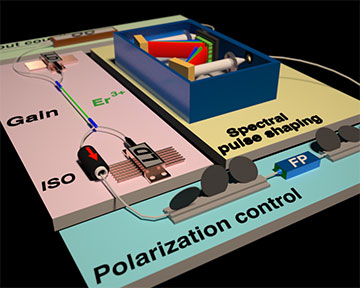![]()
Researchers Martijn de Sterke and Antoine Runge in the lab. [Credit: Louise Cooper]
Ultra-short laser pulses in the form of solitons can maintain their shape as they propagate, and can be used in advanced telecommunications as well as generating white light for spectroscopy. On the down side, however, such pulses pack little energy.
Now, physicists and engineers in Australia and the U.S. have demonstrated a new kind of laser that can produce very short and potentially high-power solitons (Nat. Photonics, DOI: 10.1038/s41566-020-0629-6). They believe that their device could prove just the thing for corneal and other types of surgery that require pulses with high peak power but small amounts of energy in absolute terms, in order to avoid damage.
Soliton laser limitations
Solitons come in many guises, having been discovered by Scottish engineer John Scott Russell in 1834 while watching a boat travelling along a canal near Edinburgh. Scott Russell noticed that when the boat stopped the bow wave it had created continued to move forward, travelling as a solitary, smooth hump for several miles.
Light can behave similarly thanks to the combined effect of dispersion and non-linearity. A broadband ultra-short laser pulse disperses when travelling along an optical fiber because the fiber’s refractive index depends on wavelength. But that phenomenon is counteracted by the Kerr effect, which slows down the pulse’s intensity peak. When these two effects cancel each other out, the result is a soliton.
Solitons can be generated by fairly simple fiber lasers, but their energy is limited since it is inversely proportional to the pulse duration. Some high-end applications, such as micromachining or non-linear microscopy, which rely on very short and high-energy pulses instead send chirped pulses through a fiber and recompress them at the end. But such lasers are complex and inefficient, and unsuited to smaller-scale applications.
Leveraging higher-order dispersion

Researchers in Australia and the U.S. have adapted a mode-locked fiber laser so that it produces “quartic” solitons that can potentially carry more energy than other types of soliton. [Credit: Darren Hudson]
The latest work shows how soliton lasers might meet this need by exploiting higher-order dispersion. Normally, solitons are made by balancing Kerr non-linearity against second-order dispersion, with higher-orders being minimized as far as possible. But in 2016, Andrea Blanco-Redondo, OSA Fellow Martijn de Sterke and colleagues at the University of Sydney, Australia, showed they could engineer photonic crystal waveguides to suppress second- and third-order dispersion while counteracting non-linearities with the fourth order.
Two years later, the group then found that these “pure-quartic solitons” ought to be potentially much more energetic than the standard variety—predicting that their energy should scale as the inverse of the pulse duration cubed.
The new work has been carried out by Blanco-Redondo, who has since moved to Nokia Bell Labs in New Jersey, USA, alongside de Sterke, Antoine Runge and colleagues in Sydney. The group has shown it can generate quartic solitons using a variation on a standard mode-locked fiber laser, having been unable to achieve the tight tolerances needed to do this using photonic crystal fibers. Normally, this kind of fiber laser would yield conventional solitons, but the researchers sent photons through a spatial light modulator that cancels the second- and third-order dispersion while generating the fourth order.
Future ultrafast research
Using a variety of measurements, they showed that the laser’s output matches theoretical expectations, its energy scaling as predicted and its sideband frequencies being typical of cavities with quartic dispersion. The pulses produced are not yet that energetic—their maximum energy is about 60 picoJoules (pico = 10-12). But the researchers plan to go beyond this, reducing the current pulse duration by perhaps a factor of 10 to achieve pulses lasting around 0.1 picoseconds, and as a consequence peak powers of hundreds of kilowatts.
Despite the promising results, de Sterke is keen to play down the prospect of any imminent practical applications. “We demonstrated the new physics, but we need to beat the best soliton lasers before thinking about commercialization,” he says, adding that the modulator could perhaps be replaced by a fixed phase mask, or, in the longer term, by a fiber whose geometry is engineered so that its dominant dispersion is fourth order.
